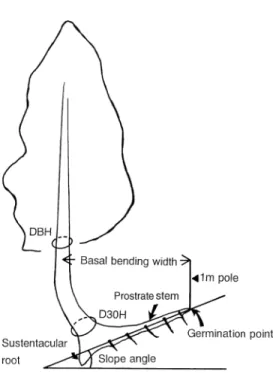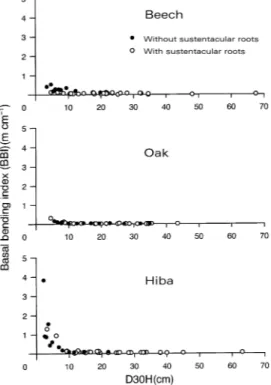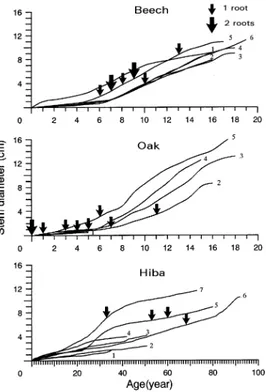Summary We compared the tolerance of hiba (Thujopsis dolabrata var. hondae Makino), beech (Fagus crenata Blume) and oak (Quercus serrata Thunb.) to creep and glide pressures of snow. The top/root (T/R) ratio of hiba trees ranged between 7.1 and 41.4 compared with 3.6--10.9 and 1.0--12.4 for beech and oak, respectively. However, if prostrate stems bearing adventitious roots were included in the root component, the T/R ratio of hiba trees was comparable to the range observed for the co-occurring broad-leaved species (1.2 to 3.9). The adventitious roots originating from the trunks of hiba trees extended horizontally during the early growth stage. However, when stem diameter at ground level reached 6--7 cm, some large-diameter adventitious roots developed vertically to form, so-called, sustentacular roots. Because all of the dead hiba trees that we examined lacked sustentacular roots, we conclude that sustentacular roots are necessary to enable young hiba trees to withstand the pressures of snow movement. All of the large beech trees formed sustentacular roots and no dead beech trees were observed. Not all the oak trees formed sustentacular roots, which may explain why this species was found only on gentle slopes.
Keywords: basal bending, root system development, snow damage, sustentacular roots.
Introduction
In much of northern Honshu Island, Japan, beech forest is considered the climatic climax, of which Fagus crenata Blume and Quercus mongolica var. grosseserrata Rehd. & E.H. Wils. are the main components (Numata et al. 1972, Miyawaki 1987). However, in the mountainous areas, patches of conifer forests dominated by hiba (Thujopsis dolabrata var. hondae Makino) or sugi (Cryptomeria japonica D. Don) are found among the beech forests (Miyawaki 1987). Hiba is a subspe-cies of T. dolabrata and is distributed in the northern half of the range of this species (Makino 1901, Hayashi 1952, Kurata 1964). The beech forest region is subject to heavy snowfalls in winter, and snow depth appears to be one of the factors limiting the geographical distribution of the component species;
F. crenata tends to be found in areas of deeper snow than Q. mongolica var. grosseserrata (Kashimura 1974, Miyawaki 1987).
In general, snow cover during the winter is beneficial for tree survival, because it maintains the temperature beneath it at about 0 °C and the RH at 100% (Sakai 1976). But although the trees are protected from freezing and desiccation, they are susceptible to fungal attack because of the high humidity and low solar irradiance beneath the snow (e.g., Daubenmire 1959, Sakai 1976). Physical damage caused by the creep and glide pressures of accumulated snow also adversely affects survival (Miyawaki 1987, Onodera 1990). The severity of such physi-cal damage is dependent on tree age. Tree seedlings can escape damage caused by snow by bending the basal portion of the main stem (Onodera 1990).
Shidei (1954) suggested that basal bending was a species-specific adaptation to the creep and glide pressures of accumu-lated snow. However, Daubenmire (1959) concluded that snow creep deformed Populus tremuloides Michx. seedling because the seedlings lacked the mechanical strength to resist the lateral pressure. Charles et al. (1972) reported that, in Idaho, snowpack and its movements cause basal bending (butt sweep) and other species-specific stem deformities in young stands of alpine fir (Abies lasiocarpa (Hook.) Nutt.), Douglas-fir (Pseudotsuga menziesii (Mirb.) Franco), grand fir (Abies gran-dis (D. Don ex Lamb.) Lindl.), Engelmann spruce (Picea engelmanni Parry ex Engelm.), western larch (Larix occiden-talis Nutt.), western hemlock (Tsuga heterophylla (Raf.) Sarg.), and western white pine (Pinus monticola Dougl. ex D. Don.). In sugi and other species common to the snowy regions of Japan, large-diameter, vertically oriented adventitious roots, i.e., sustentacular roots, are frequently observed (Inuma and Aoyama 1965, Miyawaki 1987, Onodera 1990). It has been hypothesized that sustentacular roots enable trees to withstand the creep and glide pressures of snow cover (Inuma and Aoyama 1965, Miyawaki 1987, Onodera 1990). However, apart from a study with sugi (Taira 1987), there is little infor-mation about the function of sustentacular roots. We have, therefore, examined the effects of creep and glide pressures of
Survival strategy of hiba (
Thujopsis dolabrata
var.
hondae
) and two
broad-leaved trees in northern Japan in response to creep and glide
pressures of snow
HIROMI TANABE and HIROMICHI ONODERA
Snow Influences Laboratory, Tohoku Research Center, Forestry and Forest Products Research Institute, Nabeyashiki 72, Shimokuriyagawa, Morioka 020-01, Japan
Received March 2, 1995
snow cover on the development of the root systems of co-oc-curring hiba, beech and oak trees.
Materials and methods
Study area
The study was carried out at two research sites located in Sawauchi village (39°29′N, 141°20′E, 550 m asl) and Ma-murogawa town (38°56′ N, 140°16′ E, 160 m asl), in the central part of the Ohu mountain range, northern Honshu Island. Mean annual precipitation and temperature are, respec-tively, 2432 mm year–1and 8.5 °C at Sawauchi (Site S), and 2440 mm year–1and 10.3 °C at Mamurogawa (Site M). Maxi-mum snow depth during winter reaches about 1.8 and 1.7 m at Sites S and M, respectively.
Tree census
At Site S, the DBH (stem diameter at breast height), D30H (stem diameter at 30 cm above ground) and slope angle was measured for each tree. Basal bending width of each tree, defined as the horizontal distance between the germination point and the stem at a height of 1 m, was also measured (see Figure 2). The basal bending index (BBI), i.e., basal bending width/DBH, was calculated to determine the extent to which stem bending recovered with tree growth (Higuchi and Onod-era 1993). The number of sustentacular roots per tree was re-corded. The D30H and number of sustentacular roots of dead trees that had been uprooted and were lying in a 20 × 20 m plot located on a 40° slope were also measured.
Measurements of root and stem growth
At Site S, seven hiba trees were sampled including the root systems. Root systems of five oak and six beech trees were ex-cavated at Site M, where the slope inclination was about 36°. For each sample tree, the dry weights of stems, branches, leaves and roots were determined. All roots having a basal di-ameter of > 1 cm were separated into five groups based on the direction of spatial distribution (see Figure 3). The total weight of the roots in each direction was then determined. The ratio of aboveground (stem, branches + leaves) dry weight to below-ground dry weight (T/R) was obtained for each tree. Annual growth rate of stem diameter was measured at the base of the stem by counting, with the aid of a binocular microscope, the widths of annual rings along three radii, i.e., the larger and smaller radii parallel to the slope and the radius horizontal to the slope. In the hiba trees, the annual growth rings in the smaller radius parallel to the slope were too small to measure. The ages of roots that extended vertically were determined by counting the annual rings.
Results
Root system development
The T/R ratios of hiba trees ranged from 7.0 to 41.4 (mean value was 19.0) and the corresponding values for beech and oak were 3.6–10.9 (mean = 7.1) and 1.0–12.4 (mean = 4.8),
re-spectively. All of the hiba trees had prostrate stems bearing adventitious roots (Figures 1 and 2). Inclusion of the prostrate stems bearing adventitious roots in the root component re-duced the T/R ratio of hiba trees to a range (1.2–3.9 (mean = 2.4)) comparable with the ranges observed for beech and oak.
In the small hiba trees (Nos. 1–4), the adventitious roots originating from the prostrate stems extended horizontally in both directions across the slope (Figures 3 and 4). In the large hiba trees (Nos. 5–7), the adventitious roots extended both vertically and horizontally downslope and across the slope, and the largest hiba tree (No. 7) also had adventitious roots extending horizontally upslope. Most adventitious roots of
Figure 2. Schematic illustration of a hiba tree subjected to snow creep and glide pressures.
both beech and oak tended to grow horizontally, although one beech root and a few oak roots grew vertically into the soil.
Basal bending and sustentacular roots
Figure 5 shows relationships between D30H and BBI for the hiba, oak and beech trees. For the small trees (D30H < 10 cm), the BBI of hiba was much larger than that of beech and oak, and the small oak trees (D30H < 15 cm) had a smaller BBI than the small beech trees (t-test, P < 0.001). Most of the large hiba and beech trees (D30H > 10 cm) had sustentacular roots, whereas most large oak trees (D30H = 34.8 cm) did not have sustentacular roots.
Slope angle
The steepest slope angles observed in the hiba, beech and oak trees were 51, 53 and 36°, respectively, and the corresponding mean slope angles were 38.3, 30.7 and 27.1°, respectively. Oak trees grew on gentler slopes than hiba and beech trees (t-test, P < 0.001).
Tree rings
Figure 6 shows the increases in stem diameter at ground level (D0H) with time of the sample trees. The vertically oriented roots of oak were mostly formed in the 7 years following germination. Among the beech trees examined, only two (Nos.
Figure 3. Schematic illustration of the root system showing the direc-tion of elongadirec-tion growth and the spatial distribudirec-tion of each root.
Figure 4. Spatial distribution of root dry weights of the hiba, beech and oak sample trees. The horizontal bar on the lower right-hand corner of each figure shows the weight scale (g). The nu-meral denotes the sample number (see Table 1).
4 and 5) had vertically oriented roots and these developed when the trees were 6--13 years old. At the time of sampling, none of the small hiba trees had developed vertically oriented roots (Nos. 1--4). In the large hiba trees (Nos. 5--7), the vertically oriented roots were formed when the trees were 33--68 years old.
Fallen trees
At Site S, the number of hiba trees killed by uprooting or treefall was estimated to be 150 ha−1. All of the uprooted and fallen hiba trees were small (D30H < 15 cm) and lacked sustentacular roots. No dead or fallen broad-leaved trees were observed.
Discussion
Creep and glide pressures of snow are thought to pull trees downslope. Thus, formation of upslope-oriented roots and a small T/R ratio may be advantageous for trees subjected to extreme creep and glide pressures. The T/R ratios reported by Karizumi (1979) for several Japanese conifers, including Cryptomeria japonica (3.0--4.0), Chamaecyparis obtusa (2.5--4.5), Pinus densiflora (3.2--4.3) and Larix leptolepis (3.3--4.9), are much smaller than the T/R ratios of hiba trees (7.0--41.4) in our study (Table 1). Furthermore, the hiba trees had few upslope-oriented roots in the early growth stage (Figure 4). However, if the prostrate stem was included as part of the root system, the T/R values (1.2--3.9) of hiba were similar to those reported by Karizumi (1979), suggesting that the prostrate
stems of hiba trees support the aboveground parts. Limited carbon allocation to root biomass in hiba trees may be associ-ated with the wet soil conditions under the snow cover (Karizumi 1977).
Higuchi and Onodera (1993) reported that, in Magnolia hypoleuca Sieb. et Zucc. and Aesculus turbinata L. growing in snowy regions, the adverse effects of stem bending were ame-liorated by the production of sustentacular roots. We found that, in hiba and beech trees, the return of the stem to a vertical posture following basal bending also depended on the forma-tion of sustentacular roots. However, none of the oak trees were susceptible to stem bending and hence the formation of susten-tacular roots in oak was not related to stem form. The hiba and beech trees both exhibited horizontal root systems during the early growth stages, whereas oak developed a vertical root system at an early stage (Figure 6), which may account for its ability to survive without sustentacular roots under the creep and glide pressures of snow cover. However, based on the finding that the distribution of oak is restricted to the gentle slopes and areas with low snowfall (Kashimura 1974), we conclude that oak is unable to withstand snow pressure as well as hiba and beech trees.
Shidei (1954) reported that tree mortality caused by creep and glide pressures of accumulated snow was maximal when tree height reached the maximum snow depth. In our study, the hiba trees succumbed to physical damage, e.g., treefall and
Table 1. Dimensions of sample trees.
Tree DBH D30H1 Height Age T/R Ratio (cm) (cm) (m) (years)
1 Stem diameter at 30 cm in height. 2 With sustentacular roots.
uprooting, before their D30H reached 15 cm and before pro-ducing sustentacular roots. The formation of a sustentacular root in hiba trees generally occurred when stem diameters (D30H) reached 6--7 cm (Figure 6). Thus, the success of hiba trees in this region may depend on whether the trees can produce a sustentacular root at an early stage of their growth.
The patterns of development of the root systems of hiba and beech were similar, suggesting that both species are adapted to survival in snowy mountain regions. However, hiba trees do not grown in areas with heavy snowfall (i.e., maximum snow depth > 4 m), although they maintain a presence in the popu-lation by sprouting. In contrast, dwarf beech (F. crenata) and oak (Q. mongolica var. undulatifolia) trees are common in areas with heavy snowfall (Sugita 1988); however, these trees do not achieve a DBH of more than 8--10 cm because of recurrent trunk breakage and sprouting (Tanimoto 1993). We conclude that beech trees are better adapted to areas of heavy snowfall than hiba trees.
Acknowledgments
We thank Drs. Akira Osawa, Naoko Kurachi and Takuya Kajimoto for their invaluable comments on earlier revisions of this manuscript.
References
Charles, D., R. Leaphart, R.D. Hungerford and H.E. Johnson. 1972. Stem deformities in young trees caused by snowpack and its move-ment. USDA Forest Service Res. Note INT-158, 10 p.
Daubenmire, R.F. 1959. Plants and environment----a textbook of plant autecology. John Wiley & Sons, Inc., New York, 422 p.
Hayashi, Y. 1952. Taxonomic observations of Thujopsis dolabrata
(Asunaro) and Thujopsis dolabrata var. Hondai, (Hinoki-asunaro, Hiba) and their natural distribution. Trans. 61st Mtg. Jpn. For. Soc., pp 97--98. In Japanese with English summary.
Higuchi, H. and H. Onodera. 1993. The snow hardiness of deciduous tree species: characteristics of basal bending of several deciduous trees. J. Jpn. For. Soc. 75:56--59. In Japanese.
Inuma, M. and S. Aoyama. 1965. Characteristics of root form and basal bending of sugi (Cryptomeria japonica). Bull. Tohoku Branch, For. For. Prod. Res. Inst. 5:67--70. In Japanese.
Kashimura, T. 1974. Ecological study on the montane forest in the southern Tohoku district of Japan. Ecol. Rev. 18:1--56.
Karizumi, N. 1977. Root biomass. In Primary Productivity of Japanese Forests----Productivity of Terestrial Communities. Eds. T. Shidei and T. Kira. JIBP Synthesis, University of Tokyo Press, Tokyo, Vol. 16, pp 45--52.
Karizumi, N. 1979. Illustrations of tree roots. Seibundo Shinkosha, Tokyo, Japan, 1121 p. In Japanese.
Kurata, S. 1964. Illustrated important forest trees of Japan. Chikyu Shuppan, Tokyo, Japan, pp 50--51. In Japanese.
Makino, T. 1901. Observations on the flora of Japan. Bot. Mag. Tokyo 15:102--114.
Miyawaki, A. 1987. Vegetation of Japan. Vol. 8. Tohoku, Shibundo, Tokyo, Japan, 605 p. In Japanese.
Numata, M., A. Miyawaki and D. Itow. 1972. Natural and semi-natural vegetation in Japan. Blumea 20:436--496.
Onodera, H. 1990. Snow and forest. Ringyo Kagaku Gijyutu Shinko-syo, Tokyo, Japan, 81 p. In Japanese.
Sakai, A. 1976. Adaptation of plant to deposited snow. Low Temp. Sci. Ser. B 34:47--76. In Japanese.
Shidei, T. 1954. Studies on the damage to forest tree by snow pres-sures. Bull. For. For. Prod. Res. Inst. 73:1--89. In Japanese with English summary.
Sugita, H. 1988. Environmental factors and their effects on the distri-bution of plant communities on Mt. Asakusa, a mountain with deep snow----with special relation to the growth form of Fagus crenata. Relationship between snow depth and the distribution pattern of plant communities. Jpn. J. Ecol. 38:217--227.
Taira, H. 1987. The study of mechanism of sugi basal bending and its control methods. Bull. Toyama Prefectural For. Exp. Stn. 12:1--74. In Japanese with English summary.


